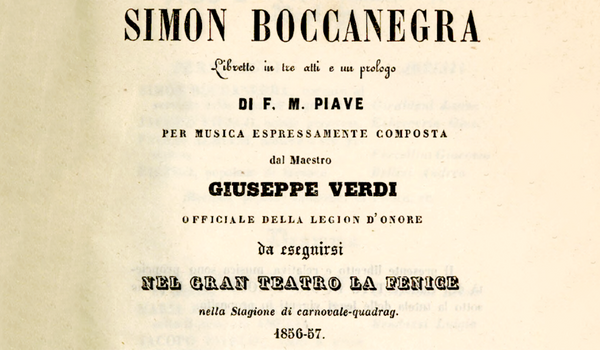To be conducting the Festival Verdi, which has been held at the Teatro Regio di Parma for twenty-two years to coincide with the birthday of Italy’s most emblematic composer, is in itself an honour.
To conduct, as I am about to do, the 1857 Simon Boccanegra, the first edition based on Verdi’s autograph score of the opera, is thrilling both for its value in terms of rigorous precision but also and, I think, above all, for its artistic value. This autograph material provides us with the opportunity to look for the first time at Verdi’s musical indications, as always rich in precious detail.
The first thing to emphasize is that this first version of Simon Boccanegra bears full testimony to Verdi’s developmental path, because when we compare the two scores, this one from 1857 with the definitive one from 1881, we can see that, over twenty years later, the composer left many pages unchanged, considering them appropriate for audiences of the late 1800s. This is very interesting because other pages, by contrast, underwent elaboration or were omitted. The latter, of course, were those with a greater flavour of the 1850s, such as the soprano’s cabaletta. By the 1880s, it was no longer the time of the cabaletta and, incidentally, this one in the 1857 Simon Boccanegra was to be the last cabaletta written by Verdi for a soprano. More significantly, in the second version Verdi made the most conspicuous changes to the second part of the first act, replacing hymns and dances with the Council Chamber Scene and the curse upon Paolo, which were to become the cornerstone of the opera. It goes without saying that this same principle in terms of stylistic development also applies to other parts of the opera, starting with the opening prelude and the initial scene between Fiesco and Paolo.
As a result, this first Simon Boccanegra bears witness to Verdi’s skill in responding to a musical and political world which had changed radically over the course of several decades and casts light on the ability of the Swan of Busseto to guide composition in new directions, towards a more international style. So, besides the artistic challenge, it is a pleasure for me to take up the challenge of rigorous precision, because I believe that the Festival Verdi and the Foundation which brings it into being (just like the one in Bergamo dedicated to Donizetti, where I have the honour of being music director) have the task of working alongside the relevant academic institutions, supporting and enhancing their research.
Simon Boccanegra will be on stage at the Teatro Regio di Parma from 25th September to 14th October, in a new production with stage direction by Valentina Carrasco, scenery by Martina Segna and costumes by Mauro Tinti. I am conducting the Filarmonica Arturo Toscanini and the Chorus of the Teatro Regio di Parma prepared by Martino Faggiani. And I will have at my disposal a superb cast including Vladimir Stoyanov in the title role, Roberta Mantegna, Riccardo Zanellato, Piero Pretti and Devid Cecconi.

Poster for the world premiere of Simon Boccanegra. Teatro La Fenice, 12 March 1857

